The Ultimate Guide to DIY Solar Panel Installation

Are you looking to harness the power of the sun and save on your electricity bills by installing solar panels at home? DIY solar panel installation can be a cost-effective and rewarding project. With the right knowledge and tools, you can set up your solar power system and start generating clean energy for your household. This ultimate guide will walk you through the process of installing solar panels on your own. Refer: https://www.yourenergyadvantage.com/solar.
Benefits of DIY Solar Panel Installation
Before diving into the installation process, let's explore some of the benefits of DIY solar panel installation:
Cost Savings
- DIY installation can save you money on labor costs.
- You can shop around for the best deals on materials and equipment.
Learning Experience
- Gain valuable knowledge about solar power systems and how they work.
- Develop skills in electrical work and renewable energy.
Customization
- Design a solar power system that meets your specific energy needs.
- Choose the placement and orientation of your solar panels for optimal efficiency.
Planning Your Solar Panel Installation
Assess Your Energy Needs
Before you start purchasing materials, determine how much electricity you want your solar panels to generate. Consider factors such as your average energy consumption, peak usage times, and any future energy needs.
Suitable Location
Identify a suitable location for your solar panels. Ideally, the location should receive ample sunlight throughout the day with minimal shading from trees or buildings. Ensure that the roof or area where you plan to install the panels can support the weight.
Budget and Financing
Set a budget for your DIY solar panel installation project. Research the cost of solar panels, inverters, mounting hardware, and other necessary components. Explore financing options such as solar loans or incentives to help offset the initial investment.
Installing Solar Panels
Acquire the Necessary Permits
Before you begin the installation, check with your local government or building department to obtain the required permits for installing solar panels. Compliance with regulations ensures the safety and efficiency of your solar power system.
Install Mounting Hardware
Start by installing the mounting hardware for your solar panels. Depending on the type of roof you have, you may use roof racks, rails, or a ground-mounted system. Follow the manufacturer's instructions for proper installation.
Connect the Solar Panels
Once the mounting hardware is in place, it's time to connect the solar panels. Lay out the panels according to your design and secure them to the mounting system. Connect the panels in series or parallel, following the wiring diagram provided with your solar panels.
Install the Inverter
The inverter is an essential component that converts the DC electricity generated by the solar panels into AC electricity for use in your home. Install the inverter near your main electrical panel and follow the manufacturer's instructions for wiring and setup.
Connect to the Grid
If you plan to connect your solar power system to the grid, you may need to work with a qualified electrician to ensure proper connection and compliance with local regulations. Grid-tied systems allow you to sell excess electricity back to the utility company.
Maintaining Your Solar Power System
Regular Cleaning
Keep your solar panels clean to ensure optimal performance. Regularly remove dirt, dust, and debris that may accumulate on the panels. Use a soft brush, water, and a mild detergent to gently clean the surface.
Monitor Performance
Monitor the performance of your solar power system to detect any issues or inefficiencies. Keep track of energy production levels, inverter readings, and any error messages. Address any abnormalities promptly to maintain the efficiency of your system.
Professional Inspections
Consider scheduling periodic inspections by a qualified professional to ensure that your solar power system is functioning correctly. An inspection can identify potential issues early on and prevent costly repairs down the line.
Conclusion
DIY solar panel installation can be a fulfilling project that allows you to harness renewable energy and reduce your carbon footprint. By following this ultimate guide and taking the necessary steps to plan, install, and maintain your solar power system, you can enjoy the benefits of clean and sustainable energy for years to come.